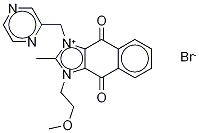Description
YM-155 (781661-94-7) is a novel small molecule survivin suppressant. YM-155 suppresses expression of survivin (a member of the IAP family) and induced apoptosis in human tumor cell lines at 10 nmol/L with little effect on other IAP or Bcl-2 family members.1?Overcomes erlotinib resistance in EGFR mutation-positive non-small cell lung cancer.2?Induces DNA damage.3?YM-155 induces an autophagy-dependent cell death in adenoid cystic carcinoma cells.4
Uses
YM155 is a potent IAP (inhibitor of apoptosis proteins) inhibitor for survivin with IC50 of 0.54 nM.
Uses
YM155 is a novel small-molecule survivin suppressant that suppressed expression of survivin and induced apoptosis in PC-3 and PPC-1 human HRPC. cell lines. Potent Survivin Inhibitor.
Definition
ChEBI: Sepantronium bromide is an organic bromide salt consisting of sepantronium cations and bromide anions. It has been found to selectively inhibit survivin (BIRC5) gene promoter activity and to down-regulate survivin in vitro, so leading to induction of apoptosis. It has a role as an antineoplastic agent, a survivin suppressant and an apoptosis inducer. It contains a sepantronium.
References
1) Nakahara?et al. (2007),?YM155, a novel small-molecule surviving suppressant, induces regression of established human hormone-refractory prostate tumor xenografts; Cancer Res.?67?8014
2) Okamoto?et al. (2012),?Overcoming erlotinib resistance in EGFR mutation-positive non-small cell lung cancer cells by targeting survivin; Mol.Cancer Ther.?11?204
3) Glaros?et al. (2012),?The ‘survivin suppressants’ NSC 80467 and YM 155 induce a DNA damage response; Cancer Chemother. Pharmacol.?70?207
4) Wang?et al. (2014),?Induction of autophagy-dependent cell death by the survivin suppressant YM155 in salivary adenoid cystic carcinoma; Apoptosis?19?748



